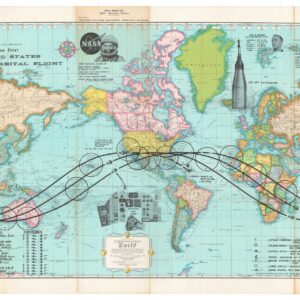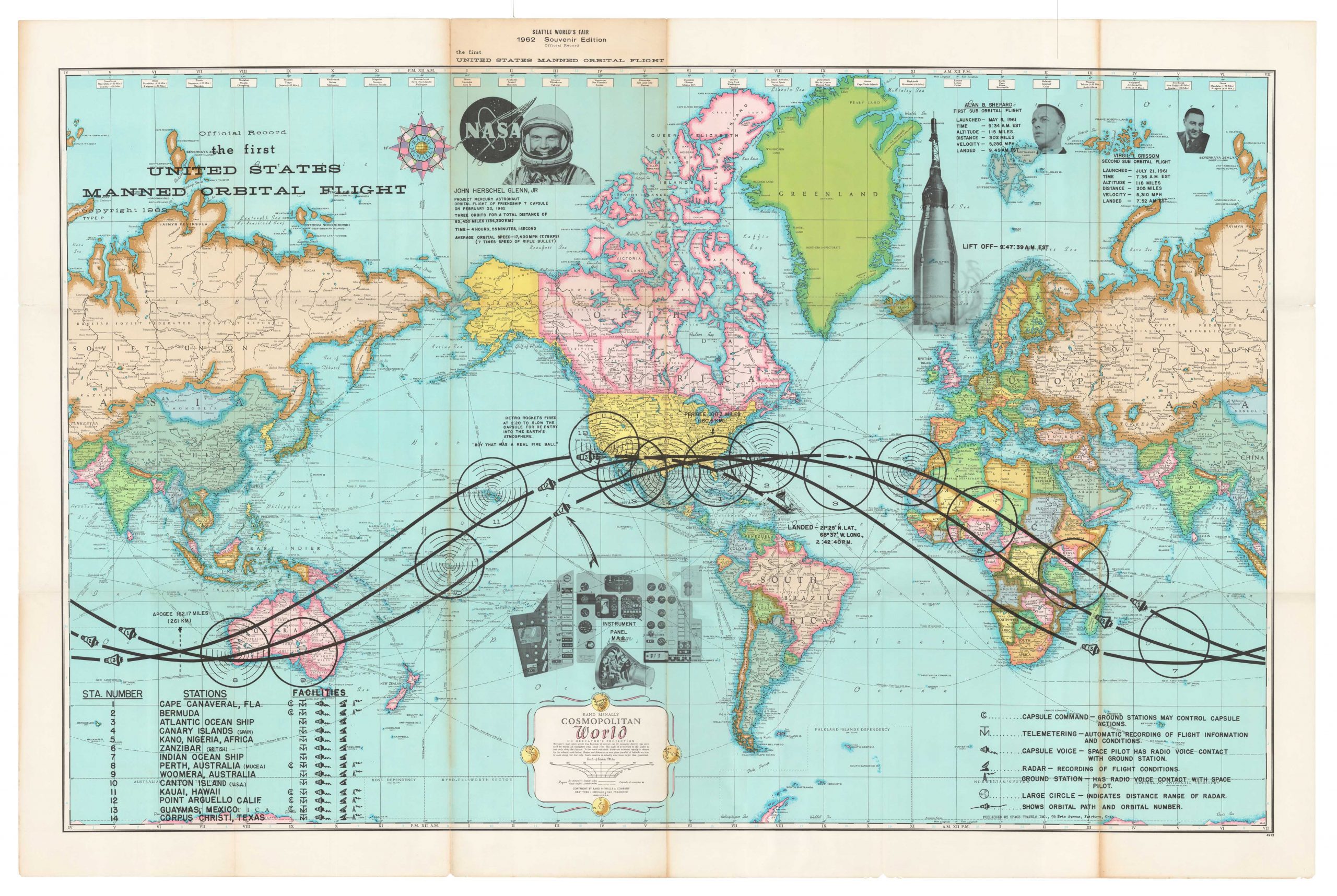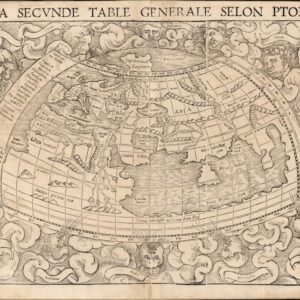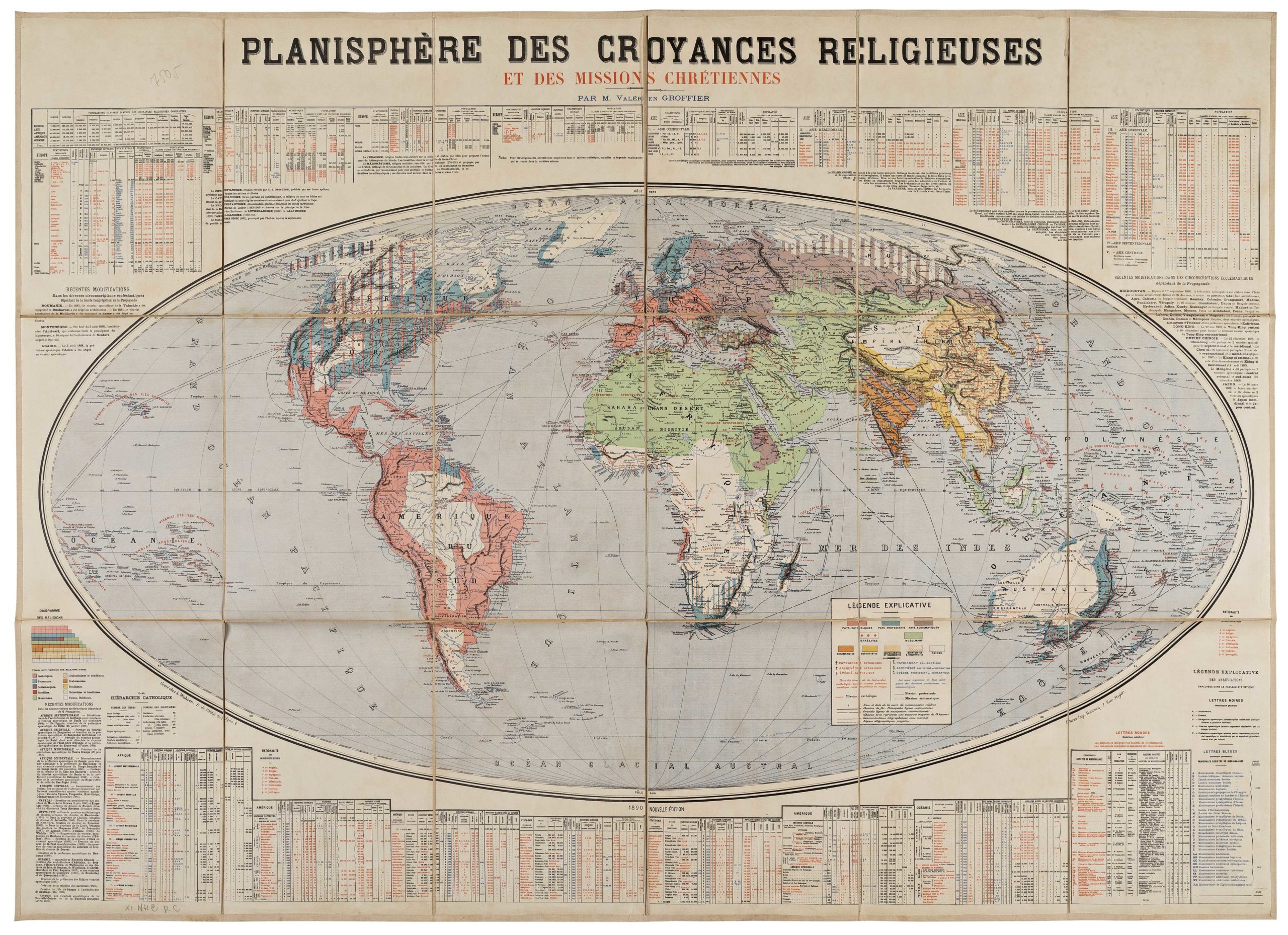With California attached to Asia and Canada attached to Europe!
Carta Marina Nuova Tavola.
$1,600
1 in stock
Description
Cartographic myths, new discoveries, and authoritative precursors: the world on the cusp of geographic understanding.
First published in 1561, the Carta Marina appeared in the first edition of Ruscelli’s Ptolemaic geography and emulated a slightly smaller map published by Giacomo Gastaldi in 1548. This 1548 map, in turn, constituted a simplified version of Gastaldi’s famous world map, the Universale, from 1546, which has become virtually extinct on the open market.
Ruscelli’s version appeared in multiple editions of his Geografia (1561,1562, 1564, 1574) and was reissued in Giuseppe Rosaccio’s expanded edition of Ruscelli’s atlas in 1598 and again in1599. Consequently, the Ruscelli Carta Marina constitutes an authentic and affordable representation of one of the great masterpieces of the Lafreri School of cartography.
Maps constitute one of the best avenues for discerning the rapid and uneven development of geographic knowledge during the 16th century. Among the discernible differences between Ruscelli’s map and its Gastaldi predecessors are their geographic composition and applied toponymy – especially regarding those components of the earth which modern viewers would find entirely unrecognizable.
Most remarkable is the idea that the Americas constituted the easternmost reaches of Asia. This was somewhat of a paradigm among Italian mapmakers and was related to the still prescient vision that one could reach the Indies by heading west. Magellan had discovered and plotted the southern passage to the Pacific, but nobody had yet ventured far enough north to disprove this theory of connectivity. In many ways, however, this notion was already antiquated when Ruscelli first published it. German mapmakers like Münster or Mercator were not buying this model. Yet remnants of the idea lingered on in maps throughout the 16th century.
Another fascinating land bridge is the physical connection between North America, Greenland, and Arctic Scandinavia. While the Asia-America connection was an established trope and one actively advocated by Gastaldi, the origin of the America-Europe land bridge is not as clear-cut. Indeed, this was not a feature in the Gastaldi prototypes. The key to understanding the Ruscelli model can be found in an elongated and eastward tilting Greenland, which connects Scandinavia to the American Northeast. This notion went back to Martin Waldseemüller’s Ptolemaic world map from 1513 and was later emulated and kept alive by Laurent Fries. By connecting America to Asia and Europe, Ruscelli reduced the world to a single great landmass encircling the entire planet. The fact that such a notion was somewhat strained is perhaps reflected in the fact that as part of his ‘re-modeling,’ Ruscelli omitted the ‘Tierra del Bacalaos’ toponym that Gastaldi had used on his maps.
Before moving to another fascinating feature, a final observation should be made that while Ruscelli in this map binds the continents together to form a singular whole, he also published his Orbis Descriptio the same year. In this double-hemisphere map, Ruscelli maintains America’s physical connection to Asia but severs it from northern Europe.
Another feature of the earliest days of American mapping is the reduction of the East Coast to little more than an isthmus. In doing so, Ruscelli retains an enormous northern bay known as the Sea of Verrazzano. This famous cartographic myth derived from the Florentine explorer of the same name, who in 1524 became the first European to explore the Atlantic coast between Florida and New Brunswick. Like most of his contemporaries, Verrazzano had been charged with finding a way to East Asia. While this did not happen, he did scale the entire eastern seaboard and became the first to demonstrate that the Spanish territories in the south were connected to the English counterparts in the north.
Sailing up the East Coast was not straightforward, however. It was a region marred by storms and constantly changing winds, and Verrazzano was forced to tack into the Atlantic and back to the coast continuously. While this allowed some progress, it also meant that certain features along the coastline were overlooked. When Verrazzano, on one occasion, closed in on the coast near the outer banks of North Carolina, he thought that he could see across a narrow strait and into the Pacific beyond and reported it as such in at least one of his letters home. In all likelihood, he had struck upon Pamlico Sound, or possibly the opening of Chesapeake Bay. Still, once reported, the notion was quickly adopted and incorporated into some of the most defining maps of the 16th century, including this one.
In contrast to the conservative view of continental separation, we find fresh new details almost exclusively in this period’s purview of Italian mapmakers. Standing out among such features on this map is the highly early delineation of the California Peninsula.
Cartographer(s):
Girolamo Ruscelli (1518–1566) was an Italian mathematician, polygraph, and cartographer active in Italy during the early 16th century. He was born around 1518 in Viterbo to a family of minor nobility and humble origins. Throughout his life, Ruscelli moved around, living all over Italy. He started in Aquilea, but his work soon drew him to more important centers of learning. He moved first to Padua, and around 1540, he settled in Rome, where he founded his Accademia dello Sdegno. Around 1545, Ruscelli left Rome for Naples, and in 1548 he finally settled in the city that would make him most famous, Venice.
While posterity primarily remembers Ruscelli as one of the most important cartographers of the Venice School, his primary source of income came from publishing – both his works and copying the work of others. While he wrote on a broad range of subjects himself, the works plagiarised from others were often published by his partner, Plinio Pietrasanta. This lucrative relationship lasted until 1555 when Ruscelli was arrested and tried by the Inquisition for re-publishing a satirical poem by Pietrasanta without his formal permission. Any confrontation with the Inquisition was unpleasant enough, but Ruscelli may have been particularly susceptible to pressure because his wife’s family entertained Protestant sympathies. His brother-in-law was burned at the stake in Rome some years later.
The relationship with Pietrasanta had nevertheless soured, and the publishing firm was soon closed. Instead, Ruscelli partnered up with another Venetian publisher, Vincenzo Valgrisi. It was with Valgrisi that Ruscelli published his famous Ptolemaic Geografia in 1561. This atlas contained sixty-nine engraved maps sporting the latest ideas in Italian cartography. Despite containing some of the latest cutting-edge ideas about the world’s composition, Ruscelli’s atlas also drew heavily on earlier works. Forty of the 69 maps in Ruscelli’s atlas were copied almost directly from Giacomo Gastaldi’s Geografia from 1548.
Despite Ruscelli’s fame as a cartographer, he also achieved considerable recognition under his pseudonym Alessio Piemontese. His greatest success in this regard came the same year as his arrest (1555), with the publication of De Secreti del Alessio Piemontese. In this book of alchemy, Ruscelli reveals himself as a true Renaissance man, dabbling proficiently in multiple disciplines at the same time. His ‘Secrets‘ contained instructions on how to make everything from alchemical compounds and medicines to cosmetics and dyes. The work was so popular that it was re-issued numerous times over the next two centuries, and translated into French, English, German, Latin, Dutch, Spanish, Polish, and even Danish.
Condition Description
Sporadic soiling and stains and expert repairs.
References





